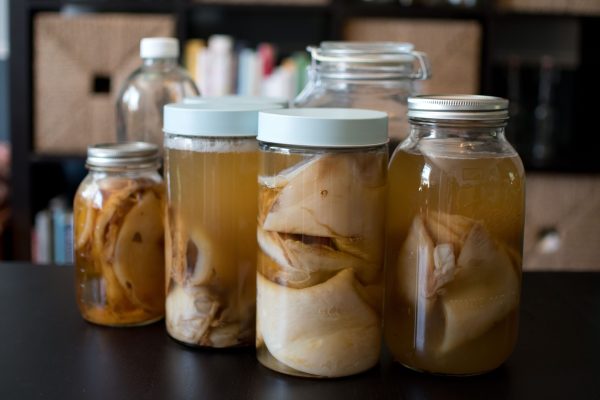So you woke up one day and saw that your SCOBY was not looking as usual so you asked the question “Is my SCOBY dead?” Well, if your SCOBY has turned black and has molded over it already then it probably is but if not, don’t panic yet because SCOBYs don’t die easily.
A Symbiotic Colony of Bacteria and Yeast or SCOBY is an essential part in brewing Kombucha. A SCOBY is a living organism that encourages fermentation. It is naturally tough and can maintain its health for a long time. However, if a SCOBY is not well fed and placed in a suitable environment, it is possible for SCOBY to get contaminated by mold and even insects. When the SCOBY is contaminated, it can die and stop the fermentation process.
If you are a new home brewer and are thinking about the possible death of your SCOBY, then this article is a must read for you. Today, we will discuss everything you need to know about dead SCOBYs as well as how to revive and when to replace this brewing culture.
Table of Contents

Is My SCOBY Dead?
The easiest way to tell if the SCOBY is dead is by looking at its appearance. Dead SCOBYs are very distinct and easy to spot because of the change in their color. You will see that the dead SCOBY has turned black and some mold could be visible on its surface. Mold has a fuzzy appearance and often has white, gray, or green color.
In addition to the color and the appearance of molds, another strong indication that the SCOBY is dead is when it starts to give off a bad odor that is similar to the odor of decaying or rotting matter. When this happens, your entire brew will likely acquire the smell so it’s best to start a new batch instead of allowing your Kombucha to ferment longer.
The appearance and smell are the strongest signs in identifying a dead Kombucha. However, If you are still not yet convinced if your SCOBY is dead after examining its appearance and smell, then you can take a pH test.
Kombucha brews need to have a low pH level of between 4 to 2. This pH level is acidic enough to inhibit the growth and development of harmful microorganisms that can damage the SCOBY. Seeing this acidity level can also tell you if the Kombucha is still fermenting and if the SCOBY is still up and well. However, if the pH level of the brew is more than 7, then there is a huge chance that the SCOBY is not capable of fermentation anymore and has already been spoiled.
So what should you do with your dead SCOBY? The simple answer is to throw it away together with the batch of tea that was brewed using it. Take note that dead SCOBYs are very likely to have molds in them, which may not be safe for ingestion.
An article published by healthline.com notes that mold can produce mycotoxins which are harmful chemicals to humans and animals. These chemicals may cause various diseases and death depending on factors like amount consumed, length of exposure, and the state of health of the organism.
Do not feel discouraged if your SCOBY has died. A dead SCOBY doesn’t always mean that you did something wrong or you are a bad brewer. Just like we have said above SCOBYs are alive and just like any living beings, their lifespan can also end.
What Does a Dead SCOBY Look Like?
SCOBYs do not look identical at all. Their appearances vary from each other in terms of size, color, texture, and shape. But dead SCOBYs have one thing in common when it comes to their appearance and that is their color. Dead SCOBYs tend to turn black. You will also likely spot dry and fuzzy molds that are white or colored around the dead SCOBY. These molds can appear in spots or cover the SCOBY entirely.
Moreover, you may see that a dead SCOBY is relatively small. This is because unhealthy SCOBYs tend to stop growing and forming SCOBY babies. However, a small SCOBY is not a strong indicator of a retired SCOBY. Sometimes SCOBYs just take time to grow due to the temperature and other factors.
How Do I Know If My SCOBY is Still Good?
The best way to know if your SCOBY is still good is to examine it by its appearance. Additionally, you should test your Kombucha brew’s appearance, taste and smell. Keep reading for more detailed instructions on how to check your SCOBY’s health.
First of all, you have to make your Kombucha as usual with the SCOBY and allow fermentation for at least a week. After a week, open your fermentation jar and examine your brew’s appearance. When you open the jar, you may see small bubbles on the surface. These bubbles are from the yeast and are completely normal. These bubbles are also a good sign that the yeast is healthy. Next, check the SCOBY. A healthy SCOBY should be able to grow and cover the surface of the brewing jar. If the progress of fermentation is fast, you may even see a small formation of a SCOBY baby.
Furthermore, you should see that the SCOBY has already changed its color from darker to a lighter shade. The change in the color of the SCOBY is usual in brewing Kombucha and you shouldn’t panic. This happens simply because the tannins from the tea, which gives the tea its color, is already broken by the SCOBY. That means that the fermentation is going well and your SCOBY is well capable of fermentation.
After observing the appearance of your brew and SCOBY, take a sample for a taste test. A healthy SCOBY should be able to transform sweet tea into a tangy drink. The Kombucha should also have a pleasant sweet-sour smell.
If some of these signs are not yet visible on your Kombucha after one week, do not worry. The progress of fermentation varies from batch to batch so the signs can vary as well. Just give your SCOBY and Kombucha some time and test regularly.
How Do I Revive My SCOBY?
Before attempting to revive your SCOBY, it’s best to examine your SCOBY’s condition first. If you left your SCOBY in a Kombucha hotel for months, the first thing you should notice is the smell. If there is no decaying smell in the Kombucha hotel liquid, then you can feel a little relieved because there can be a chance that your SCOBY can still be used. Now it’s time to check your SCOBY.
If your SCOBY hasn’t turned black yet and there are no formation of molds around it, then it is very possible that you can revive and use your SCOBY again for brewing Kombucha.
Depending on the length of storage, a SCOBY that has been left in a hotel can have abundant yeast on their surface. Yeasts look like dark brown strings that hang off from the SCOBY. Having yeast around your SCOBY is okay and totally normal.
However, you will have to remove the extra yeast from the SCOBY. This is because the excess yeast can affect the balance in your brew. The yeast will be working together with the bacteria for fermentation. If the yeast is too much then chances are the bacteria will be thrown out of balance.
How to Remove Excess Yeasts from the SCOBY?
To remove the excess yeasts from the SCOBY, you will need to use your hands and carefully remove them. Make sure that your hands are clean when cleaning your SCOBY to prevent contamination.
If your SCOBY has grown thick, you can trim it to accommodate new growth. You may also opt to only use the baby portion of the SCOBY and use the old portion as an ingredient for SCOBY recipes and more.
By now, your SCOBY should be ready for fermentation.
Is My SCOBY Still Good for Brewing Kombucha?
In order to see if your SCOBY is still good for brewing Kombucha, you will need to start a new batch. Make your Kombucha as usual with sweet tea, starter tea, and your newly revived SCOBY.
You can use the Kombucha hotel liquid as a strong starter tea to help kick out the fermentation. However, if you do this you should filter the yeast from the liquid first to make sure that the yeast and bacteria in the brew are in perfect balance. Fermentation Culture suggests using a coffee filter in filtering the yeast from your hotel liquid.
Just a quick tip, if you are using a SCOBY that hasn’t been used for a long time, it’s better to only brew a small batch of Kombucha. This will make sure that your SCOBY can have an adequate amount of sugars to stay healthy.
Brew your Kombucha for one week and more. After a week, you should test your brew. If the taste has transformed into a more acidic flavor then your Kombucha is fermenting. The smell should also be sweet and sour.
If your Kombucha is fermenting properly that means your SCOBY is healthy and suitable to use for the next batches.
When Should I Replace My SCOBY?

If you are consistently brewing good kombucha you should never need to replace or discard your SCOBY pellicles. Now, you may need to trim them or remove layers as it gets too thick, but never replace it completely unless it is showing signs of distress.
The time to replace your SCOBY is when it has already died or developed mold. You may also want to change your SCOBY if it is continuously struggling to ferment. However, if you do not have a SCOBY replacement and you are certain that your SCOBY is not yet dead and just having a hard time fermenting, then you may just need to change some things in your fermentation process.
These include increasing the temperature and fermentation time, adding more sugar and starter tea, and allowing the entry of more oxygen to the SCOBY. Doing these can speed up the fermentation and help your SCOBY in growing and brewing.








